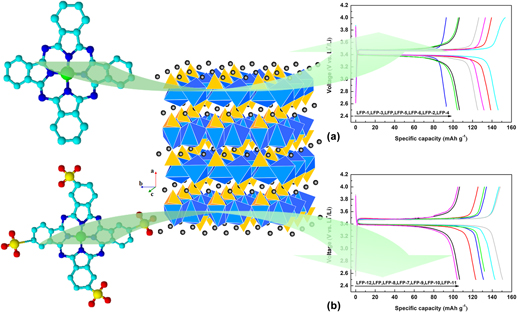Crossref Citations
This article has been cited by the following publications. This list is generated based on data provided by
Crossref.
Wang, Ruiqiong
Zhang, Ronglan
Xu, Bei
Yang, Fei
Zhao, Jianshe
Zhang, Shichao
and
Wang, Junlong
2015.
Metal tetrabromophthalocyanines mediate the structure and electrochemical performance of lithium iron phosphate as cathode materials for lithium-ion batteries.
Journal of Electroanalytical Chemistry,
Vol. 755,
Issue. ,
p.
47.
He, Rui
Liu, Zhenfa
Zhang, Lihui
Guo, Ruhui
and
Yang, Shujuan
2016.
Electrochemical properties of V and Ti co-doping Li1.02FePO4/C material prepared by solid-state synthesis route.
Journal of Alloys and Compounds,
Vol. 662,
Issue. ,
p.
461.
Xu, Feifei
Wang, Ruiqiong
Zhang, Ronglan
and
Zhao, Jianshe
2017.
Structure and electrochemical performance of LiFePO4modified with mononuclear and binuclear phthalocyanines as cathode materials.
Journal of Materials Research,
Vol. 32,
Issue. 6,
p.
1168.
Su, Yuanyuan
Xu, Feifei
Wang, Ruiqiong
Zhang, Ronglan
and
Zhao, Jianshe
2018.
Microstructure and electrochemical performance of LiFePO4 cathode materials modified with binuclear metal aminophthalocyanines.
Journal of Porphyrins and Phthalocyanines,
Vol. 22,
Issue. 12,
p.
1072.
Su, Yuanyuan
Zhang, Ying
Zhang, Ronglan
Yang, Fei
and
Zhao, Jianshe
2018.
Synthesis and performance evaluation of binuclear metal phthalocyanines as high-efficiency electrocatalysts for Li/SOCl2batteries.
Journal of Materials Research,
Vol. 33,
Issue. 16,
p.
2376.
Zhang, Ying
Zhang, Ronglan
Xu, Feifei
and
Zhao, Jianshe
2019.
Surface Structures, Crystal Orientation, and Electrochemical Behavior of Modified LiFePO4 by Novel Strategies.
Energy Technology,
Vol. 7,
Issue. 10,
Li, Zhaojin
Yang, Jinxing
Guang, Tianjia
Fan, Bingbing
Zhu, Kongjun
and
Wang, Xiaohui
2021.
Controlled Hydrothermal/Solvothermal Synthesis of High‐Performance LiFePO4 for Li‐Ion Batteries.
Small Methods,
Vol. 5,
Issue. 6,
Liu, Zhihua
Zhang, Ronglan
Xu, Feifei
Gao, Yan
and
Zhao, Jianshe
2022.
Structure and electrochemical performance of LiFePO4 cathode materials modified with carbon coating and metal doping.
Journal of Solid State Electrochemistry,
Vol. 26,
Issue. 8,
p.
1655.
